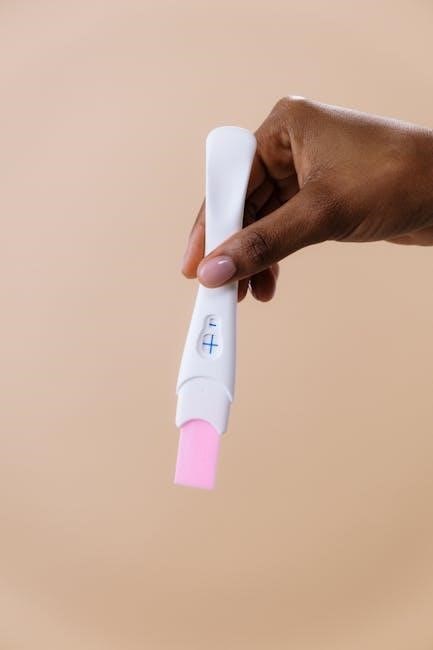The Proov PdG Test is an innovative tool designed to measure PdG levels in urine, helping confirm ovulation and monitor hormone activity. This non-invasive method empowers individuals to track their reproductive health accurately and cost-effectively.
What is the Proov PdG Test?
The Proov PdG Test is a urine-based diagnostic tool that detects the presence of PdG (progesterone metabolite) to confirm ovulation. It measures hormone levels after ovulation, providing insights into reproductive health. This non-invasive, at-home test is designed to help individuals track their menstrual cycle and fertility. By monitoring PdG levels, users can gain a better understanding of their hormone activity and verify successful ovulation. It’s a user-friendly solution for fertility tracking and cycle monitoring.
Importance of Proov PdG Test for Hormone Tracking
The Proov PdG Test is crucial for hormone tracking as it validates ovulation by detecting PdG, a progesterone metabolite. This confirmation is vital for understanding cycle regularity and fertility. By identifying hormonal patterns, individuals can assess reproductive health, aiding in family planning or diagnosing issues. Accurate PdG levels provide insights into progesterone function, ensuring informed decisions for conception or menstrual health management.

Understanding PdG and Its Role in the Body
PdG is a metabolite of progesterone that reflects ovarian function. It plays a key role in confirming ovulation, essential for reproductive health and fertility tracking.
What is PdG (Progesterone Metabolite)?
PdG, or progesterone metabolite, is a naturally occurring compound produced when the body breaks down progesterone. It is excreted in urine and serves as an indicator of progesterone levels, which are essential for confirming ovulation and monitoring fertility. By measuring PdG, individuals can gain insights into their reproductive health and cycle regularity, making it a valuable tool for those trying to conceive or track their menstrual cycle.
The Role of Progesterone in the Menstrual Cycle
Progesterone is a crucial hormone produced after ovulation, playing a vital role in preparing the uterus for a fertilized egg. It thickens the uterine lining, supports embryonic development, and maintains pregnancy. Without sufficient progesterone, conception and implantation can be challenging. Tracking progesterone levels through PdG testing helps confirm successful ovulation and identify potential hormonal imbalances, providing valuable insights for fertility and reproductive health management.
How the Proov PdG Test Works
The Proov PdG Test detects PdG in urine, indicating progesterone levels post-ovulation; It uses test strips that change color based on PdG concentration, confirming ovulation quickly and non-invasively.
The Science Behind PdG Testing
PdG (pregnanediol glucuronide) is a metabolite of progesterone, produced after ovulation. Proov test strips detect PdG in urine, indicating successful ovulation. The test relies on immunoassay technology, where antibodies specific to PdG bind to the metabolite, causing a color change on the strip. This non-invasive method accurately reflects hormonal activity, providing insights into reproductive health and confirming ovulation with precision.
How to Use Proov Test Strips
Using Proov test strips involves collecting a urine sample and inserting the strip into it. The test detects PdG, a progesterone metabolite, with results appearing in minutes. Follow the instructions carefully for accurate readings, ensuring proper handling and timing to avoid errors. This method allows individuals to monitor their hormone levels conveniently and effectively at home.
Preparing for the Proov PdG Test
Proper preparation ensures accurate results. Avoid excessive fluid intake before testing and refrain from using medications that may interfere with hormone levels. Timing is crucial.
When to Take the Test
The Proov PdG Test should be taken after suspected ovulation, typically during the luteal phase. Begin testing 7-10 days post-ovulation to detect PdG levels accurately. For best results, test in the morning when PdG concentrations are highest. Consistency in timing ensures reliable outcomes. If unsure about ovulation timing, start testing 7 days after your longest cycle length to align with potential ovulation. This approach helps confirm whether ovulation has occurred and if the corpus luteum is functioning properly;
Things to Avoid Before Testing
To ensure accurate results, avoid certain factors before using the Proov PdG Test. Refrain from taking progesterone supplements or medications that may interfere with hormone levels. Limit excessive fluid intake, as it can dilute the urine sample. Avoid testing too early in the luteal phase, as PdG levels may not yet peak. Additionally, avoid testing during menstruation, as this can disrupt hormone detection. Proper timing and preparation are crucial for reliable outcomes.

Collecting the Sample for Proov PdG Test
Collect a urine sample in a clean, dry container. Test in the morning for highest PdG levels. Avoid excessive fluid intake beforehand to ensure accurate results.
Step-by-Step Guide to Sample Collection
Collect a midstream urine sample in a clean, dry container. 2. Avoid excessive fluid intake beforehand. 3. Test in the morning for highest PdG levels. 4. Dip the test strip into the sample, ensuring the arrows point downward. 5. Remove excess urine by touching the strip to the rim of the container. 6. Wait 3-5 minutes for results to appear. Follow instructions carefully for accurate outcomes.
Tips for Accurate Results
For precise results, test in the mid-morning when PdG levels peak. Avoid excessive fluid intake to prevent diluting the sample. Use a first-morning sample if timing allows. Ensure the test strip is stored at room temperature and not expired. Avoid touching the test strip’s absorbent area to the container rim. Do not submerge the strip beyond the max line indicated. Follow instructions carefully to ensure reliability and consistency in testing outcomes.

Interpreting Proov PdG Test Results
Understanding PdG levels is crucial for tracking reproductive health. Elevated levels post-ovulation confirm successful ovulation, while low levels may indicate issues. Accurate interpretation aids in fertility planning and cycle monitoring effectively.
How to Read the Test Results
To interpret Proov PdG test results, compare the color intensity of the test strip to the reference chart provided. A darker band indicates higher PdG levels, confirming ovulation. Results are ready within minutes. Ensure accurate timing and avoid contaminants for reliable outcomes. Proper hydration and testing at the right time enhance result clarity. Consistent testing helps track hormone trends, aiding fertility planning and cycle monitoring effectively. Always follow the instructions carefully for precise readings.
Understanding Test Accuracy
Proov PdG tests are highly accurate when used correctly. The test detects PdG levels, a reliable indicator of progesterone presence, confirming ovulation. Accuracy depends on proper timing, hydration, and avoiding contaminants. Results may vary if instructions aren’t followed. Ensure tests are taken consistently and within the specified timeframe for optimal reliability. External factors, like medications, can influence results, so adherence to guidelines is crucial for precise outcomes and effective hormone tracking.

Clinical Significance and Implications
The Proov PdG Test aids in diagnosing fertility issues and monitoring conditions like PCOS by confirming ovulation and hormone function, providing critical insights for clinical decisions.
Confirming Ovulation with PdG Levels
Proov PdG Test detects the presence of PdG, a progesterone metabolite, in urine. Elevated PdG levels typically indicate successful ovulation, as progesterone rises after an egg is released. By testing 7-10 days after suspected ovulation, individuals can confirm if ovulation occurred. This method is particularly useful for fertility tracking, as it provides direct evidence of hormonal activity post-ovulation, helping identify patterns or potential issues in the menstrual cycle.
Identifying Potential Cycle Issues
The Proov PdG Test aids in detecting irregularities in the menstrual cycle by analyzing PdG levels. Low or inconsistent PdG levels may indicate issues like anovulation or a luteal phase defect. By tracking these levels, individuals can identify potential hormonal imbalances or cycle irregularities. This insight is crucial for addressing fertility concerns or irregular periods, enabling timely medical evaluation and appropriate interventions to restore cycle health and improve reproductive outcomes.
Troubleshooting Common Issues
Common issues with Proov PdG Test include invalid results or test strip errors. Retesting or consulting the instructions often resolves these problems, ensuring accurate outcomes.
Common Mistakes to Avoid
- Not following the instructions precisely can lead to inaccurate results.
- Testing too early or too late in your cycle may miss the PdG surge.
- Improper handling of test strips, such as exposing them to moisture, can affect accuracy.
- Ignoring the timing of urine concentration may result in misleading outcomes.
- Failing to wait the recommended time before reading results can cause errors.
Solving Inconsistent or Confusing Results
If you encounter inconsistent or confusing results with the Proov PdG test, ensure you’re following the instructions precisely. Timing is crucial—test during the correct window after suspected ovulation. Avoid diluting your urine sample and wait the recommended time before reading results. Proper handling of test strips is essential to maintain accuracy. If issues persist, consult a healthcare provider to address potential underlying conditions affecting hormone levels.

Advantages and Limitations of Proov PdG Test
The Proov PdG Test offers an effective, non-invasive method for tracking PdG levels, aiding in ovulation confirmation. However, it has certain limitations that users should be aware of.
Advantages of Using Proov PdG Test
The Proov PdG Test offers numerous benefits, including non-invasive urine testing, cost-effectiveness, and the ability to confirm ovulation accurately. It provides individuals with clear insights into their hormone levels, aiding in fertility tracking and reproductive health management. The test is easy to use at home, making it a convenient option for those seeking to monitor their menstrual cycles and plan conception effectively.
Limitedations and Potential Drawbacks
While the Proov PdG Test offers valuable insights, it has some limitations. Results may not always detect low PdG levels accurately, and timing of the test is critical for reliability. Additionally, individual variations in hydration and metabolite excretion can affect outcomes. The test does not provide information on other hormones, such as estrogen, and is not intended for diagnosing medical conditions. Proper interpretation of results is essential to avoid misleading conclusions.
The Proov PdG Test is a valuable tool for tracking reproductive health, offering insights into ovulation and hormone activity through non-invasive, user-friendly urine testing.

Final Thoughts on Using Proov PdG Test
The Proov PdG Test offers a reliable, non-invasive method to confirm ovulation and monitor hormone levels, empowering users to gain insights into their reproductive health. By providing clear, actionable data, it helps individuals make informed decisions about fertility and menstrual cycle management. While the test is user-friendly, consulting a healthcare provider for personalized interpretation ensures the best outcomes. This innovative tool is a valuable addition to reproductive health tracking, offering both convenience and accuracy for those seeking to understand their hormonal balance.

No Responses